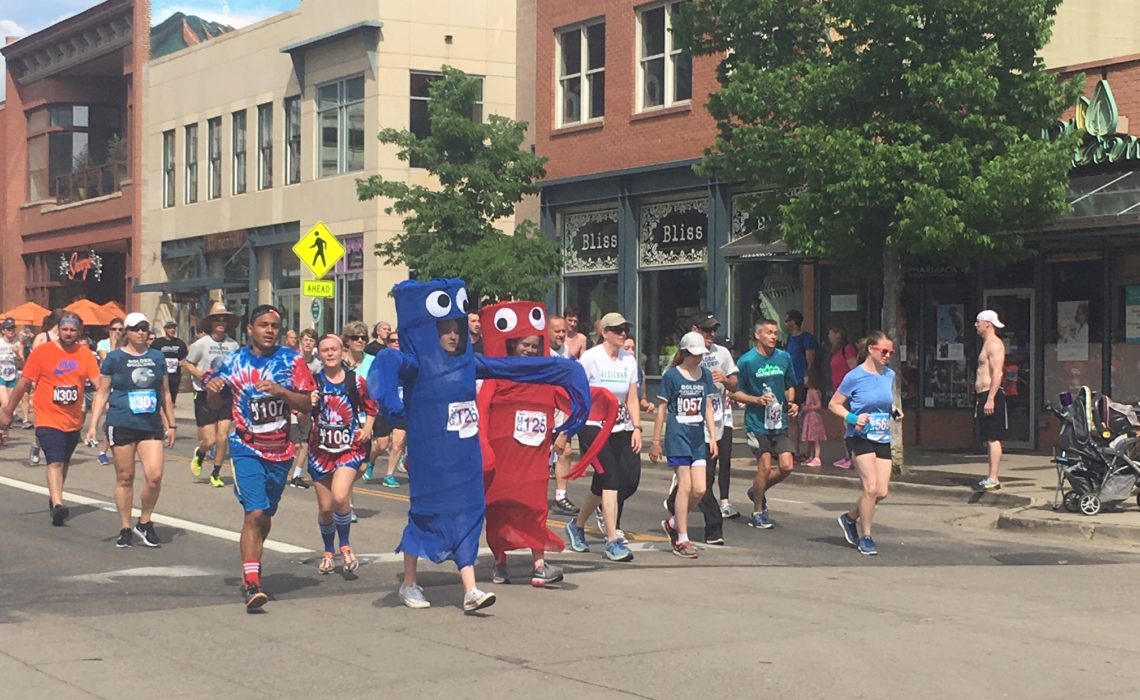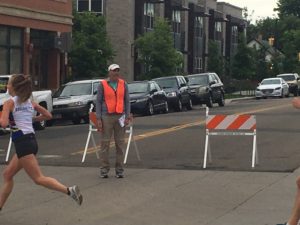
As I approached Barker Park, a group of 20 people or so gathered around. Only for the BolderBoulder would a group be gathered at 6 a.m. in this location. A woman with a ball cap shouted directions:
“Make sure you check in and get your t-shirt and jacket. Who hasn’t received their assignment yet?”
Race Marshal
I dutifully picked up my maps, bright orange vest and snack bag, and walked to my assigned spot at 17th and Pearl. Not sure what to expect, I positioned myself along the barricades awaiting the first participants in the BolderBoulder.
During the past several years, I’ve been one of the many runners and walkers to take part in the 10-kilometer race. I ran along the wooded streets, passing the belly dancers and bands, as well as the slip and side. Like so many others, I suffered running up the final hill to Folsom Field before entering the stadium, making a final push to the finish line.
But last winter has been difficult for me health-wise. I’ve suffered with plantar fascitiis in my feet, making them feel stiff every morning. Running just didn’t seem appealing. An auto-immune disorder sapped some of my energy as well. I just couldn’t find it in me to put in the training necessary to complete the 6.2 miles.
I know friends who don’t train but run the race anyway, but that’s never been my style. If I sign up for a race, I try to be as prepared as possible. Of course, some suffering is expected, but overall, I like to feel good about my running.

my fellow race marshal volunteer
Instead, this year I volunteered to be one of the many race marshals along the course. And after standing for six hours at my assigned spot, I gained a new perspective of the race.
You Got This
With around 50,000 runners competing, I knew the BolderBoulder is one of the biggest running races in the country. But running in the race, I never quite sensed the enormity of the entire race. Watching wave after wave of runners and walkers keep coming over the course of five hours helped me understand the mass of humanity participating.
Watching the diversity of people taking part inspired me. Kids as young as five years old, holding on to their father’s hand, running with sheer abandon. Older people with gimpy knees, heavily taped, shuffling along, but not giving up. A lot of ordinary people, not particularly athletic, giving it their all to complete those ten kilometers. People running with friends and family dressed up as dinosaurs, not looking for a personal best time, but instead a good time.
Armed with a mini-cowbell, I shouted encouragement.
“You got this! You can do it! Looking good!”
In return, I received many thank yous and a multitude of high fives from runners of all ages.
I saw the wheelchair racers flying along at 6:45 a.m. with literally no one to cheer them except us volunteers. I gazed in awe at the strength of their upper body and the speed at which they moved.
The climax turned out to be the last 15 minutes when the elite racers competed. These lithe, sinewy runners moved like gazelles, moving in the most fluid and effortless way possible. And yet the speed at which they ran belied the intensity and focus to their running.
Moving is Always a Good Thing
Most of all, I was left with the importance of events like these in creating moments for people to get outside and move. Technology has given many gifts to us to make the world a more accessible a place. But at the same time, it has created a world of isolation, and lack of movement.
Any event that inspires us to challenge ourselves, get outside and get moving can only be a good thing for our community.

